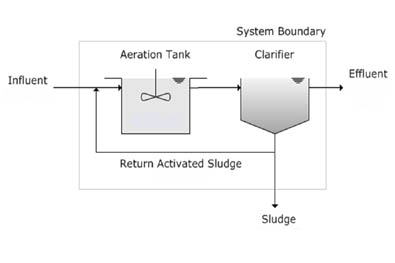The activated sludge process which is a suspended growth system is a conventional wastewater treating process which can produce high degree of biological treatment in reasonably compact facilities when compared to the earlier tickling filters. Two stages of treatment are generally used in the activated sludge process. In the first stage, a contaminated waste stream is contacted with activated sludge, which comprises microorganisms.The microorganisms feed on the contaminants in the waste stream and metabolize these contaminants to form cellular structures and intermediate products. After decontamination is completed, the decontaminated stream and activated sludge are transported to a clairifier where the sludge particles are separated by gravity from the decontaminated stream. Typically, a portion of the sludge is recycled back to the first stage for contact with the incoming contaminated waste stream.
The main advantage of activated sludge process is that it requires less space than the biological filter (Tickling Filter). The second advantage is that a final effluent of high quality is produced such that it does not require high dilution for disposal.
Welcome to Engineered Solutions

